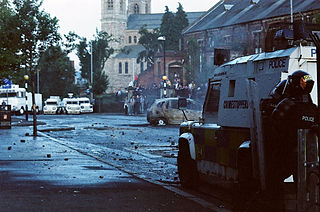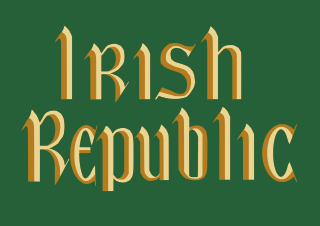Related Research Articles
The Real Irish Republican Army, or Real IRA (RIRA), was a dissident Irish republican paramilitary group that aimed to bring about a United Ireland. It formed in 1997 following a split in the Provisional IRA by dissident members, who rejected the IRA's ceasefire that year. Like the Provisional IRA before it, the Real IRA saw itself as the only rightful successor to the original Irish Republican Army and styled itself as simply "the Irish Republican Army" in English or Óglaigh na hÉireann in Irish. It was an illegal organisation in the Republic of Ireland and designated as a proscribed terrorist organisation in the United Kingdom and the United States.
This is a chronology of activities by the Continuity Irish Republican Army (CIRA), an Irish republican paramilitary group. The group started operations in 1994, after the Provisional Irish Republican Army began a ceasefire.
This is a timeline of actions by the Irish republican paramilitary groups referred to as the Real Irish Republican Army and New Irish Republican Army. The Real IRA was formed in 1997 by disaffected members of the Provisional IRA. Since July 2012, when Republican Action Against Drugs (RAAD) and other small republican groups merged with it, the group has been called the New IRA; although it continues to call itself simply "the Irish Republican Army".

Óglaigh na hÉireann is a small dissident Irish republican paramilitary group that took part in the dissident Irish Republican campaign. The organisation started carrying out attacks around 2009 and was formed after a split within the Real IRA, led by Seamus McGrane.

The dissident Irish republican campaign began at the end of the Troubles, a 30-year political conflict in Northern Ireland. Since the Provisional Irish Republican Army called a ceasefire and ended its campaign in 1997, breakaway groups opposed to the ceasefire and to the peace agreements have continued a low-level armed campaign against the security forces in Northern Ireland. The main paramilitaries involved are the Real IRA, Continuity IRA and formerly Óglaigh na hÉireann. They have targeted the Police Service of Northern Ireland (PSNI) and the British Army in gun and bomb attacks as well as with mortars and rockets. They have also carried out bombings that are meant to cause disruption. However, their campaign has not been as intensive as the Provisional IRA's, and political support for groups such as the Real IRA is "tending towards zero".

The 2011 Northern Ireland riots were a series of riots between 20 June 2011 and 16 July 2011, starting originally in Belfast, before spreading to other parts of Northern Ireland. They were initiated by the Ulster Volunteer Force.

From 6 to 11 July 1997 there were mass protests, fierce riots and gun battles in Irish nationalist districts of Northern Ireland. Irish nationalists/republicans, in some cases supported by the Provisional Irish Republican Army (IRA), attacked the Royal Ulster Constabulary (RUC) and British Army. The protests and violence were sparked by the decision to allow the Orange Order to march through a Catholic/nationalist neighbourhood of Portadown. Irish nationalists were outraged by the decision and by the RUC's aggressive treatment of those protesting against the march. There had been a bitter dispute over the march for many years.
During the 2012 North Belfast Riots sectarian disorder and rioting between loyalists and republicans occurred when rival parades, authorised by the Parades Commission, took place.

On 3 December 2012, Belfast City Council voted to limit the days that the Union Flag flies from Belfast City Hall. Since 1906, the flag had been flown every day of the year. This was reduced to 18 specific days a year, the minimum requirement for UK government buildings. The move to limit the number of days was backed by the council's Irish nationalists while the Alliance Party abstained from the vote; it was opposed by the unionist councillors.
The 2005 Belfast riots were serious loyalist riots and civil disturbances in Belfast, Northern Ireland in September 2005. The violence broke out after the Protestant Orange Order Whiterock parade was re-routed to avoid the Irish nationalist Springfield Road area. Clashes also broke out in several towns in County Antrim. The incidents took place amid a fierce feud between members of the Ulster Volunteer Force (UVF) and Loyalist Volunteer Force (LVF), who are also thought to have orchestrated the riots.
The 2001 South Armagh attacks were attacks on two watchtowers and a police station in South Armagh, Northern Ireland.

The 2002 Short Strand clashes, also known as the siege of Short Strand, was a series of major sectarian violence and gun battles in and around the Short Strand area of east Belfast – a mainly Irish/Catholic enclave surrounded by Protestant communities. Although violence had occurred many times throughout 2002, this article deals with the worst episode in June.
On 12 July 2001, major rioting and civil disorder broke out in Ardoyne, north Belfast, Northern Ireland. In some of the worst rioting in years, 113 police officers were injured in clashes which followed a July 12 parade. Police were attacked when trying clear the path for about 100 Orangemen returning from the parade to go through the Catholic Ardoyne area.
The May 2002 Belfast riots were riots that occurred in north Belfast, Northern Ireland. On Saturday May 2002, up to 800 people were involved in sectarian clashes beginning shortly after the Scottish Cup Final in which Rangers F.C. beat Celtic F.C. Petrol bombs and fireworks were thrown at Police Service of Northern Ireland (PSNI) officers. That night 28 police officers and 10 civilians were injured, including two Protestant men who were shot.
Large civil disorder broke out in north Belfast, Northern Ireland on Sunday 11 November 2001. The trouble started when republicans clashed with loyalists during a Remembrance Day service. Up to 400 Protestants and Catholics were involved in rioting in the afternoon on North Queen Street.
The 2018 Derry riots were riots and civil disturbances taking place in Derry, Northern Ireland from 8 July 2018, before the Protestant Orange Order parade. It was the first 12 July parade to take place in Derry for five years. Violence broke out in the republican Bogside area in what has been called the worst in the city in "decades". The Police Service of Northern Ireland (PSNI) has blamed the New IRA group for trying to kill police officers. Riot police fired plastic baton rounds, whilst at least 70 petrol bombs have been thrown at them.
Events from the year 2021 in Northern Ireland.
A series of riots in loyalist areas of Northern Ireland began in Waterside, Derry, on 30 March 2021. After four nights of rioting in Derry, disturbances spread to south Belfast on 2 April, where a loyalist protest developed into a riot involving iron bars, bricks, masonry and petrol bombs. Following this, civil unrest spread to Newtownabbey on 3 April, where cars were hijacked and burnt, and petrol bombs were also used against police. Carrickfergus in southern County Antrim also saw serious civil unrest on the night of 4 April and morning of 5 April, where loyalists created roadblocks to keep police out of local estates and threw petrol bombs at police vehicles.

The New Irish Republican Army, or New IRA, is an Irish republican paramilitary group. It is a continuation of the Real Irish Republican Army, which began to be called the 'New IRA' in July 2012 when Republican Action Against Drugs (RAAD) and other small republican militant groups merged with it. The group calls itself simply "the Irish Republican Army". The New IRA has launched many attacks against the Police Service of Northern Ireland (PSNI) and the British Army. It is the largest and most active of the "dissident republican" paramilitary groups waging a campaign against the British security forces in Northern Ireland.
References
- ↑ McDonald, Henry (14 July 2010). "Belfast rioters 'will not plunge Northern Ireland back into conflict'". the Guardian.
- ↑ "Three officers shot during riots". BBC News. 12 July 2010.
- ↑ McDonald, Henry (12 July 2010). "Up to 30 Northern Irish police officers injured during nationalist rioting". the Guardian.
- ↑ McDonald, Henry (12 July 2010). "Police officer seriously injured after loyalist march ends in sectarian riot". the Guardian.
- 1 2 "NI rioting 'will cost millions'". BBC News. 13 July 2010.
- ↑ "Derry rioting 'among worst in decade'". BBC News. 13 July 2010.
- 1 2 "Northern Ireland riots: police attacked in Belfast for fourth night". 15 July 2010 – via www.telegraph.co.uk.
- ↑ Jepson, Kris. "Cameron: Belfast riots 'completely unacceptable' - Channel 4 News". www.channel4.com.
- ↑ "Major arrests promised over riots". BBC News. 14 July 2010.